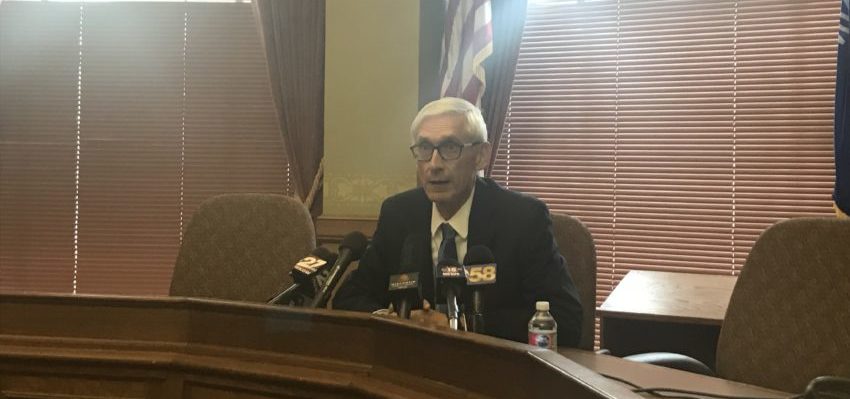
The state superintendent makes a broad case for his budget request at annual State of Education address but offers few details on funding
September 21, 2018
By Ola Lisowski
Education was the talk of the town in Madison this week as State Superintendent Tony Evers made his annual State of Education address in the Capitol rotunda Thursday.
Asked where the additional $1.4 billion would come from, Evers offered few specifics while referencing larger tax increases of previous administrations.
Evers, who is running for governor as a Democrat, used the address as an opportunity to discuss some details of his budget request and speak broadly about Wisconsin’s history.
The Department of Public Instruction (DPI) budget, submitted by Evers on Monday, would increase spending by $1.4 billion. The plan amounts to a 10 percent increase over funding levels in the 2017-19 state budget.
The funding request is similar to Evers’ past budget proposals, centering on what he calls the “Fair Funding for Our Future” plan. That plan would move multiple streams of revenue to the general aid formula, sending more dollars through equalization aid. The school levy tax credit, first dollar credit, and high poverty aid would all be moved to general aid funding.
Asked where the additional $1.4 billion would come from, Evers offered few specifics while referencing larger tax increases of previous administrations.
“It’s around priorities. That’s a smaller increase than [former Gov.] Tommy Thompson had several years ago,” Evers said in comments to media following the speech. “That money was found in the budget and I plan to do it again. Certainly part of it comes from the school levy tax credit and that will be applied so that districts don’t have to essentially raise the levy in order to capture something they already should be getting. But at the end of the day, that increase of 10 percent is doable within the present budget. It’s always been that way. It’s about finding priorities, and my priority is going to be around K-12 education.”
Evers insisted that taxes would not necessarily increase under his plan. At the same time, he said taxes have increased in recent years, calling Gov. Scott Walker a “tax and spender.”
“I reject the notion that somehow I’m a tax and spender when Scott Walker’s been doing exactly that,” Evers said. “I reject the assumption that taxes are going to be going up. And taxes have gone up under Scott Walker. All those millions of people who voted for referenda, school referenda. They did it because Scott Walker has decided not to fund public schools.”
State aid to schools increased by more than $636 million overall in the last budget cycle…Evers famously called the plan a “pro-kid budget.”
State aid to schools increased by more than $636 million overall in the last budget cycle. Walker had originally requested an increase as high as $649 million over prior funding, but the increase was trimmed down by the Legislature. Evers famously called the plan a “pro-kid budget.”
School district referenda have indeed increased in recent years. Recent research by the Wheeler Report showed that voters have raised taxes by $9.7 billion in school referenda since 1999.
At the same time, Walker’s administration has produced an estimated $8.7 billion in tax relief since 2011. Since entering office, Walker has made property tax control a priority, and the tax assessment on a median-valued home has fallen compared to 2010.
Documents published by DPI say that property taxes would not increase under the plan. Evers, in his speech, also said that his proposal would “hold the line on property taxes.”
Under current law, the school levy tax credit is used to offset property taxes increases at the local level. The tax credit appears on property owners’ tax bills lowering the amount they must pay. In Evers’ plan, that money—$1 billion in the current biennium—would instead flow through the general aids formula and go directly to school districts. The plan also includes a “hold harmless” provision so that no district would receive less than it currently does.
The plan would implement a new minimum aid level of $3,000 per full-time equivalent (FTE) student. No minimum aid level currently exists in law, but on average, districts spend $11,375 per student, according to the Education Commission of the States, which uses 2015 figures.
Economically disadvantaged students in all school districts would be given an additional weight of 20 percent per FTE within the general aid formula. The current 2017-19 budget provides $16.8 million in high poverty aid. School districts automatically receive the aid if at least half of the student enrollment is economically disadvantaged.
Under the Fair Funding plan, significantly more money would flow through the equalization aid formula rather than categorical aids. Equalization aid is distributed based upon the level of poverty in a district, so high-poverty areas such as Milwaukee Public Schools are weighed more heavily. Under categorical aids, the mechanism increasingly preferred by Walker’s administration, all districts receive equal amounts of money based on student enrollment.
The 2017-19 budget, for example, spent $509 million more than the previous budget on categorical aids. Every district received a funding increase of $200 per student in 2018 and another $204 in 2019.
Under Evers’ plan, $596.3 million more would flow through general equalization aids over the biennium. The plan would increase revenue limit authority to schools by $200 per student in the first year and $204 in the second.
Another change under Evers’ proposal would be a massive increase to special education aids totaling $600 million over the biennia. The request is over six times more than the $88.5 million Evers requested in 2017 during his last budget request.
Agency budget requests are the first step of each biennial budget and are treated as a starting point for the process. In February, the governor will introduce his own budget for 2019-21. After that, the Legislature will add its own changes to the document.